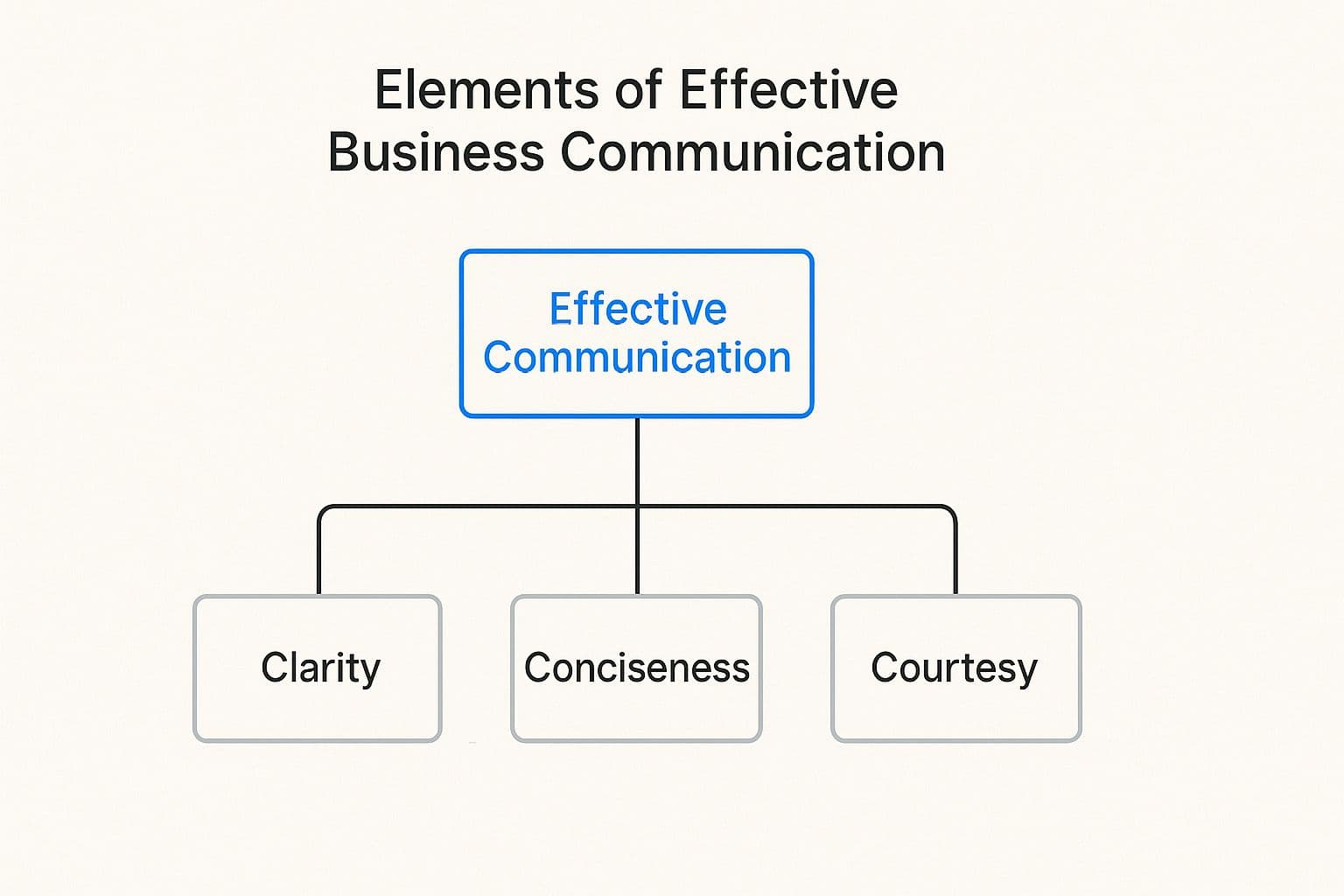Mastering Business Communication Skills Training
Unlock your team's potential with our guide to business communication skills training. Discover practical strategies to boost productivity and collaboration.

At its core, business communication skills training is simply a program that helps your employees get better at talking, listening, and sharing information with each other. It’s all about turning those moments of "Wait, what did they mean by that?" into "Okay, I get it, let's do this."
Think of it less as a fluffy "soft skill" and more of a critical investment in how your business actually runs. It’s about making sure every message lands exactly as intended, driving real results.
Why Communication Training Is a Game Changer

Ever feel like your team is playing a game of telephone? You know the one—where a simple message starts at one end and comes out completely mangled at the other. It’s a quiet but incredibly expensive problem that leads to blown deadlines, annoyed clients, and a team that’s just plain worn out.
It’s like an orchestra where every musician has a different sheet of music. The talent is there, but the result is noise, not a symphony. A business with poor communication works the same way. Without a shared playbook on how to talk and listen, even the most skilled people will end up pulling in different directions.
The Modern Workplace Demands Better Communication
With teams spread out remotely, working across different time zones, and drowning in a sea of digital messages, the old ways of communicating just don't cut it anymore. There are so many more chances for things to get lost in translation. A quickly typed email can come across as harsh, a virtual meeting can feel disengaged, and that one critical detail can disappear into a noisy chat channel.
This isn't just about preventing mistakes. It's about building a solid foundation for your company's culture. Great communication is what fosters trust and makes people feel safe enough to speak up.
When employees feel heard and understood, they bring their best selves to work. They're more creative, more engaged, and more committed. It's what turns a collection of individuals into a powerful, unified team ready to take on anything.
More Than Just a "Nice-to-Have" Skill
Pouring resources into communication training isn't a luxury anymore; it’s a core business strategy. The numbers back this up. The global market for soft skills training, which is where business communication fits, was valued at around USD 33.4 billion in 2024.
And it's not slowing down. That market is expected to balloon to nearly USD 92.6 billion by 2033, a clear signal that companies everywhere are waking up to its importance. You can dig into more of the data on this trend over at GlobeNewswire.com.
Ultimately, sharp, empathetic communication is the scaffolding for everything else you do. It’s what ensures a brilliant idea doesn't die on the vine. It helps teams work through disagreements and build stronger bonds with clients. Getting this right is the first step to unlocking your team's true potential.
The Real-World Payoff of Great Communication

Putting money into business communication skills training isn't just about making meetings less painful or tidying up a few emails. It’s about rewiring how your entire company operates, and the payoff is real, measurable, and often surprisingly quick.
Think of it as the difference between a team paddling in circles and one rowing in perfect sync toward the same goal. Clear communication is the oil that keeps the gears of your business turning smoothly. When messages land just right, projects pick up speed and you sidestep the costly delays that always come from misunderstandings.
A Direct Surge in Team Productivity
When everyone is on the same page, the effect on output is immediate. Projects that used to drag on for weeks suddenly get done faster because everyone knows exactly what to do and, just as importantly, why they're doing it. Less time is spent asking "wait, what did you mean by that?" and more time is spent actually getting work done.
This isn't just a gut feeling; the numbers back it up. Well-connected teams can see their productivity jump by as much as 25%. On the flip side, a massive 86% of employees and execs blame poor communication for most workplace failures. When you connect those two stats, the value of this training becomes impossible to ignore. You can dig into more of these stats over at Pumble.com.
At the end of the day, fewer mistakes mean less rework. That saves time, money, and a lot of headaches. It’s a straight line from better conversations to a healthier bottom line.
Boosting Morale and Keeping Your Best People
Productivity is one thing, but the impact on team morale is huge. People want to feel heard and respected. When leaders and colleagues communicate with clarity and a bit of empathy, it creates a culture where it’s safe to float a new idea, admit a mistake, or ask for help without fear.
That positive vibe is a powerful tool for keeping your best people around. Employees who feel connected and understood are way less likely to have one foot out the door. High turnover is a killer, costing you not just in recruitment fees but also in lost knowledge and team chemistry. Investing in communication is really an investment in your people.
A team that communicates well is a team that trusts each other. That trust is the foundation of a strong company culture, helping everyone navigate the tough times and celebrate the wins together.
Stronger Client Relationships and Healthier Sales
The ripple effect of great communication extends far beyond your office walls. It’s absolutely essential for building solid client relationships and, of course, driving sales.
- Sharper Negotiation: A well-trained team can negotiate with confidence, truly understanding what a client needs and clearly explaining the value they bring. This leads to better deals for everyone.
- Compelling Presentations: The ability to present ideas in a clear and persuasive way can be the single thing that wins you a new contract or gets a key project the green light.
- Building Lasting Trust: When you communicate with clients consistently and clearly, you build a foundation of trust that turns a one-off gig into a long-term partnership.
For many people, especially if English is a second language, feeling confident in these big moments is everything. We actually have a guide with some practical tips to help you improve your English communication skills. In a crowded market, how you say something is often just as important as what you're selling. It’s that human touch that makes people want to work with you again and again.
The Communication Skills Toolkit: What Your Team Actually Learns
So, what exactly does a top-tier business communication skills training program unpack? It’s not about fluffy concepts like "being a better communicator." It’s about building a practical, hands-on toolkit your team can use every single day to be clearer, more persuasive, and way more efficient.
Think of it like a mechanic's toolbox. You wouldn't hand them a single wrench and expect them to fix a complex engine. They need a whole set of specialized tools, each designed for a specific job. Great communication works the same way—you need different skills for speaking, listening, writing, and navigating our digital world.
Let's break down the essential skills that fill up this toolkit. A solid program gives your team a well-rounded set of abilities, ensuring they're ready for any situation.
Key Skills Developed in Communication Training
| Communication Type | Core Skills | Why It Matters |
|---|---|---|
| Verbal Communication | Clarity, Conciseness, Tone of Voice, Public Speaking, Presentation Skills | This is all about making sure your spoken words land with impact, whether it's in a one-on-one or in front of a crowd. |
| Non-Verbal Communication | Body Language, Eye Contact, Active Listening | Often, what you don't say is what people hear the loudest. This helps build trust and prevent misunderstandings. |
| Written Communication | Email Etiquette, Report Writing, Grammar, Proofreading, Tone | In a world of emails and Slack messages, clear and professional writing is critical for maintaining credibility and getting things done. |
| Digital Communication | Video Conference Etiquette, Collaboration Tool Use, Digital Tone Awareness | The rules change online. These skills ensure your team communicates effectively and professionally, even when they're not in the same room. |
By building out each of these areas, you're not just improving one skill; you're creating a powerful, interconnected system that elevates the entire team's performance.
Mastering What You Say and How You Say It
First up are the tools for verbal communication. This goes so far beyond just talking. It’s about mastering how you deliver a message so it actually connects, whether you're in a team huddle or presenting to the entire company.
This means getting straight to the point (clarity and conciseness) and learning how your tone of voice can completely change a message. Public speaking skills are a huge part of this, giving people a framework to tell a great story, manage their nerves, and keep an audience hooked.
For instance, an untrained manager might say, "This report is all wrong, fix it." After some training, they learn a better approach: "Great start on the report. Let's work together on strengthening the data in section two to make our case more compelling." The difference is night and day.
The Power of Not Saying a Word
Some of the most powerful messages are sent without a single word. Non-verbal communication is the silent language of the workplace, and understanding it gives your team a massive advantage.
This includes the obvious things like posture and hand gestures, but the real game-changer here is active listening.
Active listening isn't just waiting for your turn to talk. It's about fully concentrating on what the other person is saying, understanding it, and responding thoughtfully. It’s a skill that can single-handedly prevent countless misunderstandings and shows genuine respect for your colleagues.
The image below really drives home how foundational elements like clarity and courtesy are.

Without these core pillars, even the most brilliant message can completely fall apart.
Writing That Gets Results
In a world drowning in emails, reports, and instant messages, strong writing skills are absolutely non-negotiable. One sloppy email can cause confusion, frustrate a client, or just get ignored.
Training here zeroes in on a few key areas:
- Email Etiquette: Crafting subject lines that actually get opened and messages that are a breeze to read.
- Report and Proposal Writing: Structuring longer documents so the important stuff is easy to find and digest.
- Grammar and Proofreading: Making sure everything that goes out the door is error-free, which says a lot about your company's professionalism.
A consistent style is key for your brand. If you want to go deeper, check out our guide on how to create a business writing style guide for your team.
Making Sense of the Digital World
Finally, any modern communication training has to tackle the unique weirdness of the digital workplace. The old rules don't always apply when you're communicating through a screen.
This is about mastering video conference etiquette, using tools like Slack or Teams without creating more noise, and—most importantly—understanding digital tone. It’s shockingly easy to misinterpret a text-based message.
Think about it: a teammate typing "ok" in a chat could come across as dismissive. A trained communicator knows to write, "OK, that's clear. Thanks for the update!" That tiny shift makes a world of difference in building a positive remote culture.
How to Design Your Training Program for Success

A great business communication skills training program isn't something you can just pull off a shelf. It has to be built. Think of yourself as an architect—you need a solid blueprint before you can start laying bricks.
You wouldn’t give a marathon runner the same workout as a powerlifter, right? The same logic applies here. A truly successful program is designed around your team's specific goals and weak spots. It’s a strategic process that starts with figuring out what’s actually needed, choosing the right way to teach it, and knowing how you’ll measure success when it’s all over.
Start with a Communication Needs Assessment
Before you jump into solutions, you have to diagnose the problem. A needs assessment is your secret weapon for finding the real communication gaps that are holding your team back. It helps you move past guesswork and base your training on hard evidence.
This doesn't need to be a huge, formal undertaking. You can uncover a goldmine of information with a few simple techniques:
- Anonymous Surveys: Ask pointed questions. Things like, "On a scale of 1-5, how clear are project instructions?" or "What's the single biggest communication headache you deal with each week?"
- One-on-One Conversations: Just talk to people. Chatting with team members and their managers can reveal subtle issues that a survey would miss, like friction between departments or confusion about remote work norms.
- Performance Data Analysis: Look at the numbers you already have. Are projects constantly getting delayed because of misunderstandings? Is customer support getting hit with complaints about unclear instructions? This data tells a story.
By mixing these methods, you get a 360-degree view of what's really going on. This ensures your training program hits the mark from day one.
Choose the Right Training Format
Once you know what to teach, you need to figure out how. The delivery method is just as critical as the content itself. Different teams learn in different ways, so it’s worth thinking through the options.
A one-size-fits-all approach is a recipe for failure. The best programs usually mix and match formats to keep people engaged and accommodate different schedules and learning styles. This hybrid approach often gives you the best of both worlds.
Let’s break down the most common formats:
| Training Format | Pros | Cons | Best For |
|---|---|---|---|
| In-Person Workshops | Super interactive, amazing for role-playing, and builds team bonds. | Can be pricey, a pain to schedule, and tough for remote or distributed teams. | Diving deep into complex skills like negotiation or conflict resolution. |
| Online Courses | Flexible and self-paced, budget-friendly, and accessible for everyone, anywhere. | Can feel a bit lonely, requires self-discipline, and you miss out on spontaneous group discussions. | Nailing down fundamentals like email etiquette or grammar basics. |
| Hybrid Model | Blends the hands-on engagement of in-person sessions with the flexibility of online learning. | Requires careful planning to make sure the two parts feel connected, not disjointed. | Comprehensive programs covering a wide range of skills for diverse teams. |
Secure Leadership Buy-In and Measure Success
Let’s be honest: if leadership isn’t on board, your training initiative is dead in the water. When leaders actively champion the program, employees pay attention and take it seriously. You need to frame this not as a cost, but as an investment with a clear payoff.
How do you do that? Speak their language: results. Before you even launch, you need to define what success looks like in concrete, measurable terms.
Here are a few key performance indicators (KPIs) you can track:
- Faster Project Turnaround Times: Measure the average project lifecycle before and after the training.
- Higher Employee Satisfaction: Use quick pulse surveys to check in on morale and ask specific questions about communication.
- Reduced Team Conflicts: Keep an eye on the number of HR-mediated issues or informal disputes that managers have to handle.
- Improved Client Retention: Look at your client satisfaction scores. Is the feedback related to communication getting better?
When you set these benchmarks upfront, you can walk back into that leadership meeting with proof. You’ll have a powerful story to tell about the tangible value of your business communication skills training, making it a no-brainer to keep investing in it.
Use AI as Your Daily Communication Coach
Technology is no longer just a tool for sending messages; it's a powerful partner for making sure those messages are clear, effective, and productive. Think of a text-based AI as your personal communication coach, available 24/7 to help you write better, brainstorm faster, and communicate with confidence. This isn't about replacing your voice, but refining it.
Using AI for daily text-based tasks can be a game-changer for productivity. By offloading the grunt work—like proofreading, rephrasing, and summarizing—you free up valuable mental energy to focus on the core strategic thinking behind your message. The result is not only better communication but also more time back in your day.
Practical Tips for Productive Text-Based AI Use
The key to unlocking AI's potential is treating it like a smart intern: you need to give clear instructions to get meaningful results. Vague prompts lead to generic output. Specific, goal-oriented prompts deliver value. Here are some tips to integrate AI into your daily workflow:
- Draft Emails Faster: Start with a simple prompt like, "Draft a professional email to a client confirming our meeting on Friday at 10 AM. Mention that I will send the agenda tomorrow." From there, you can quickly edit it to match your personal style.
- Refine Your Tone Instantly: We've all second-guessed an email's tone. Paste your text and ask the AI, "Make this sound more friendly and collaborative," or "Adjust this to be more formal and direct." This avoids misunderstandings before they happen.
- Summarize Long Documents: Drowning in a long email thread or a dense report? Ask the AI to "Summarize the key decisions and action items from this text into five bullet points." This is a massive time-saver.
- Overcome Writer's Block: Staring at a blank page is a productivity killer. Jumpstart your process with a prompt like, "Give me three different opening hooks for a blog post about the importance of business communication."
Gaining Meaningful Benefits from AI Writing Tools
Using AI for text isn't just about speed; it's about elevating the quality and impact of your communication. When you consistently produce clear, error-free, and well-toned writing, you build credibility and trust with colleagues and clients.
Consider these meaningful benefits:
- Improved Clarity: AI can help you simplify complex ideas and eliminate jargon. Ask it to "Explain this concept as if I were talking to a beginner" to ensure your message is accessible to everyone.
- Enhanced Professionalism: Tools like TypeBoost can integrate directly into your workflow, allowing you to fix grammar, check style, and improve phrasing on the fly without breaking your concentration. This ensures every piece of communication reflects well on you and your organization.
- Increased Confidence: For non-native English speakers or those who simply lack confidence in their writing, AI acts as a safety net. It empowers them to contribute more actively and articulate their ideas with greater assurance.
By making text-based AI a regular part of your routine, you transform it from a novelty into a core productivity tool. This practical application of modern technology is a vital component of any contemporary business communication skills training, equipping every individual with the power to communicate more effectively and efficiently every day. You can discover more insights about the importance of communication in business to see just how closely these skills are linked to overall success.
Common Myths About Communication Training
Let's clear the air. A few stubborn myths often stop leaders from investing in business communication skills training, and it's a real shame. These misconceptions can bottle up a team's potential, but seeing past them is easier than you might think.
One of the biggest is the old idea that great communicators are just born with it. This paints communication as some fixed, unchangeable trait, like your height. But that’s not how it works at all. Communication is a skill, just like learning a new language or how to code—it’s a muscle that gets stronger with practice.
Then there's the other classic roadblock: the belief that teams are simply "too busy for soft skills." This dangerous idea treats training as a nice-to-have distraction from the "real work" instead of what it truly is—a powerful tool to make that real work happen smoother, faster, and better.
Busting the "No Time" Myth
Honestly, the idea that you have to shut down operations for a week-long training seminar is a thing of the past. Modern programs get that you're busy. They're built in bite-sized, focused modules that you can tackle in short bursts.
Think of it less like a massive, disruptive renovation and more like a series of small, high-impact upgrades to your team's operating system.
Investing just a few hours in the right training can save you from hundreds of hours of lost productivity down the road. All those misunderstandings, endless email chains, and frustrating re-dos? That's the real time-waster. This isn't about losing time; it's about making a smart investment.
The best programs don't just teach theory; they deliver practical techniques you can use the same day. For example, learning a simple framework for writing clearer emails can literally save every single person on your team hours each month.
Dispelling the "Natural Talent" Myth
This idea that some people are just "naturals" at communication completely misses the point. Sure, some people have a knack for it, but even the most charismatic leaders have blind spots. They can almost always get better at specific things, like active listening or learning how to give feedback that actually helps instead of hurts.
- Practice Makes Perfect: Like anything else, from shooting free throws to public speaking, clear communication becomes more automatic and intuitive when you practice it with intention.
- Everyone Can Improve: There's no ceiling here. From the brand-new intern to the most experienced CEO, there are always new techniques to learn and old habits to unlearn, especially as the way we work continues to change.
When you start treating communication as a core professional skill that can be coached and developed, you create a culture where everyone is empowered to grow. Our guide on how to improve workplace communication has some great starting points for anyone looking to level up.
At the end of the day, the most effective teams aren’t full of "natural" communicators. They're full of people who are committed to the simple goal of getting better, together.
Got Questions About Communication Training? We've Got Answers.
Still on the fence about getting business communication skills training for your team? That's completely normal. Let's tackle some of the most common questions leaders ask before they dive in.
Think of this as your practical, no-fluff FAQ to help you move forward with confidence.
How Do You Actually Measure the ROI of Communication Training?
This is the big one. Measuring the return on investment for something that feels "soft" like communication can seem a bit fuzzy, but it’s more straightforward than you might think. The trick is to stop looking for one magic number and instead track a few key business metrics that better communication directly influences.
Before you start any training, get a baseline for these areas:
- Project Completion Speed: How long do projects really take from start to finish? When communication is clear, misunderstandings drop, and timelines naturally tighten up.
- Employee Engagement Scores: You don't need a massive annual survey. Use quick pulse surveys to see how people are feeling. When people feel heard and understood, morale and engagement climb.
- Customer Satisfaction Ratings: Are your clients happy? Clear, empathetic communication is almost always a huge factor in building stronger client relationships.
Keep an eye on these same metrics for a few months after the training. The proof is in the numbers. Seeing a 10% drop in project delays or a 15% bump in client satisfaction—that’s your ROI, clear as day.
What's the Best Format for a Team That's Already Swamped?
Let’s be real: pulling a busy team out for a multi-day workshop is usually a recipe for stress and resentment. The best approach for teams with packed schedules is a flexible, hybrid model that slots into their workflow instead of disrupting it.
The goal isn't to drag people away from their jobs for days on end. It's to weave learning into their daily routine so it feels helpful, not like another meeting they have to attend.
Try a mix-and-match approach:
- Self-Paced Online Modules: Think short, digestible video lessons and quick exercises people can tackle on their own schedule—maybe on a slow Friday afternoon or first thing in the morning.
- Short, Focused Workshops: Forget all-day sessions. A powerful one-hour workshop (virtual or in-person) focused on a single skill, like how to give feedback that doesn't sting, can make a huge difference.
- On-the-Job Tools: Give them tools that help in the moment, like AI assistants or quick-reference guides they can use to apply what they've learned while writing an actual email or prepping for a meeting.
This blended style makes business communication skills training feel manageable and much less of a chore.
We're a Small Business. Where on Earth Do We Start?
If you're a small business, trying to do everything at once is the fastest way to do nothing. Don't try to boil the ocean. The smart move is to start with one, high-impact initiative that tackles your team's biggest communication headache right now.
The first step? Just ask them. Talk to your people and find out where the friction is. Are vague emails causing constant back-and-forth? Are virtual meetings a black hole of productivity?
Once you’ve pinpointed the main problem, focus all your energy there. Your first step could be as simple as a two-hour workshop on writing emails that get a response, or getting a subscription to a tool that helps everyone write more clearly. Nailing a small, visible win builds momentum and proves the value of this kind of training, making it much easier to get buy-in for more down the road.
Ready to give your team a communication superpower? TypeBoost integrates seamlessly into any workflow, allowing your team to instantly refine text, fix grammar, and adjust their tone with a simple keyboard shortcut. Stop switching tabs and start communicating with clarity and confidence. Learn more and try TypeBoost today.